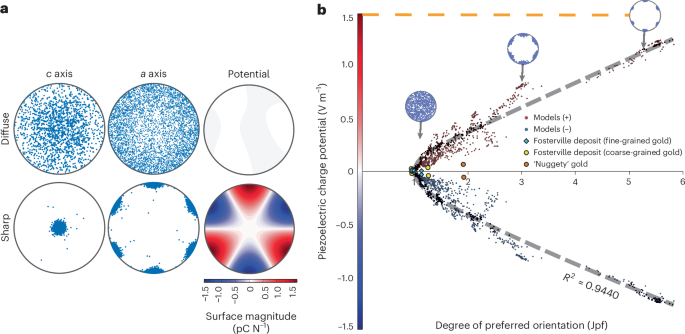Scientific research has unveiled the mechanisms through which earthquakes can trigger the formation of giant gold nuggets within quartz veins. The study was led by Chris Voisey, a geologist at Monash University in Australia.

Also Read: Scientists Discover 8-Foot Sea Scorpions Larger than Humans
Gold is often found within quartz, which is the second-most abundant mineral in Earth’s crust. Unlike other gold deposits, those in quartz veins frequently manifest as large, concentrated nuggets rather than being evenly dispersed.
Quartz veins are fractures within quartz-rich rocks, typically filled with mineral-rich hydrothermal fluids originating deep within Earth’s crust. These veins serve as the primary site for gold deposition.
An enigma in geology has been understanding how large gold nuggets, sometimes weighing up to 130 pounds, form within quartz veins.
Given that hydrothermal fluids contain very low concentrations of gold (around one part per million), it seemed improbable that such large accumulations could occur in a localized area.
While the process of gold forming in quartz has been known for decades, the specific conditions that lead to the formation of large nuggets remained unclear.
Earlier hypotheses failed to fully explain how gold atoms concentrate in such huge amounts in one discreet location within the quartz.
The study identifies orogenic gold deposits, which form as a result of tectonic activity, as the primary environment where the largest gold nuggets are found.
Earthquakes play a crucial role in this process by fracturing rocks and allowing hydrothermal fluids, which carry dissolved gold, to permeate the quartz veins.
Quartz is a piezoelectric mineral, meaning it generates an electric charge when subjected to mechanical stress such as the stress caused by seismic activity.
During an earthquake, the sudden stress on rocks causes fractures to open, allowing hydrothermal fluids rich in dissolved gold to flood into the quartz veins. In theory, this gold should be evenly distributed across the veins.
The seismic stress simultaneously triggers the piezoelectric effect in quartz, generating an electric charge within the veins. This charge interacts with the dissolved gold causing it to precipitate out of the solution and solidify on pre-existing gold grains.
Gold acts as an electrode during this process, attracting more gold atoms from the solution and enabling the growth of the nugget. With each earthquake, this cycle repeats leading to the gradual accumulation of large gold nuggets.
Also Read: Asteroid 2024 ON Set to Pass by Earth
To validate their hypothesis, Voisey and his team conducted laboratory experiments where they immersed quartz crystals in a gold-infused liquid. They then replicated the seismic waves produced by earthquakes to observe the effects on the quartz.
The experiments confirmed that the piezoelectric charge generated by the stressed quartz was sufficient to precipitate gold from the solution.
The gold was observed to preferentially solidify onto existing gold deposits, supporting the theory that nuggets grow by accretion during repeated seismic events.
Quartz possesses a unique property known as piezoelectricity. When subjected to stress, quartz can generate an electric charge. This phenomenon is familiar in everyday items like quartz watches and BBQ lighters, where a small mechanical force creates a huge voltage.
The research team hypothesized that the stress experienced by quartz during an earthquake could generate similar electric fields deep within the Earth.
To test this hypothesis, Dr. Voisey’s team designed a series of laboratory experiments that mimicked the conditions quartz might experience during an earthquake.
Quartz samples were immersed in water containing dissolved gold, simulating the natural environment where gold nuggets are often found.
These samples were then subjected to mechanical stresses designed to replicate the seismic forces generated during an earthquake.
The stress applied to the quartz created electric fields powerful enough to pull gold from the surrounding fluid and deposit it onto the quartz surface. This mechanism provides a plausible explanation for the formation of large gold nuggets and the networks of gold often found within quartz vein fractures.
The gold, once deposited on the quartz tended to accumulate on existing gold grains rather than forming new ones. This plating effect, where gold nanoparticles stick together helps explain the growth of large nuggets over time.
Quartz generates piezoelectric voltages when stressed. Gold, on the other hand is an excellent conductor. This combination results in a natural battery effect, where the quartz acts as a battery and the gold serves as the electrode.
With each seismic event, more gold is deposited leading to the gradual accumulation of gold nuggets. Over time, this process can result in the formation of massive nuggets that have sparked gold rushes and captivated treasure hunters.
Also Read: Scientists Reveal Doughnut-Shaped Structure in Earth’s Outer Core





















